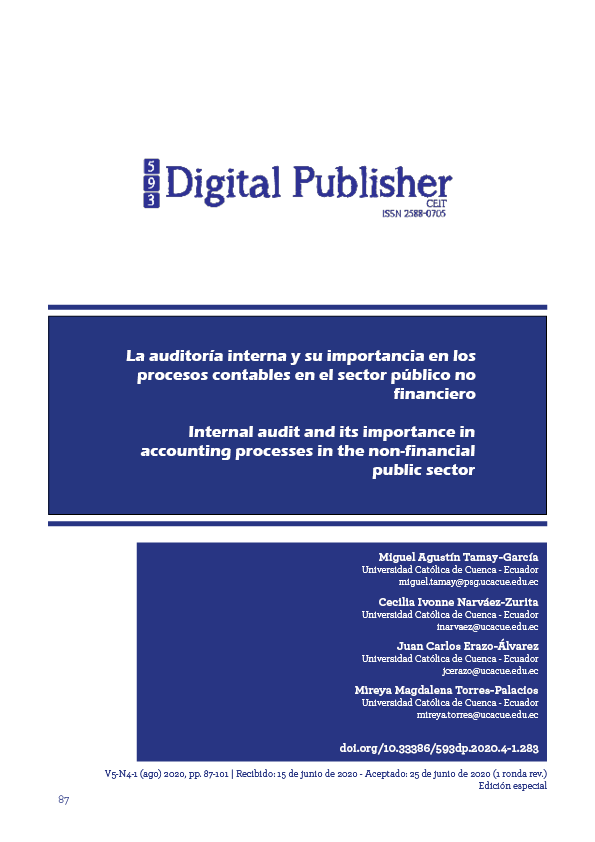Internal audit and its importance in accounting processes in the non-financial public sector
Main Article Content
Abstract
Internal auditing in public entities is an ideal tool to determine compliance with constitutional principles and accountability. Its success was manifested in accounting transactions according to the authorizations by the administration, timely registration in the period in which it was reported, in the corresponding accounts and with the correct value. In this context, based on internal control standards for public sector entities; rule 405 Financial Administration - Government Accounting, the objective is to design a model of internal audit and determine its importance in the accounting processes of the Decentralized Autonomous Government (GAD) of the parish of San Joaquín belonging to the Cuenca Canton, Province of Azuay - Ecuador, As a mechanism of transparency, reliability, integrity and timeliness of accounting information, for it to emerge, it was necessary to apply a mixed research approach, the direct quantitative approach, through a questionnaire, the collection, analysis of data and numerical measurement, to faithfully determine the level of trust and risk of the entity with respect to the internal control applied to accounting processes and, on the other hand, the qualitative approach, in order to understand its operation in accordance with the rules that govern its behavior. The results highlight its importance because it provides a set of rules, policies and procedures so that the accounting processes are carried out under the principles of effectiveness and efficiency, guaranteeing the veracity, integrity and reasonable financial information.
Downloads
Article Details
1. Derechos de autor
Las obras que se publican en 593 Digital Publisher CEIT están sujetas a los siguientes términos:
1.1. 593 Digital Publisher CEIT, conserva los derechos patrimoniales (copyright) de las obras publicadas, favorece y permite la reutilización de las mismas bajo la licencia Licencia Creative Commons 4.0 de Reconocimiento-NoComercial-CompartirIgual 4.0, por lo cual se pueden copiar, usar, difundir, transmitir y exponer públicamente, siempre que:
1.1.a. Se cite la autoría y fuente original de su publicación (revista, editorial, URL).
1.1.b. No se usen para fines comerciales u onerosos.
1.1.c. Se mencione la existencia y especificaciones de esta licencia de uso.
References
Ablan, N., & Méndez, Z. (2010). Los sistemas de control interno en los entes descentralizados estadales y municipales desde la perspectiva COSO. Visión Gerencial (1), 5-17.
Bacallao, M. (2009). Génesis del control interno. Contribuciones a la Economía. Obtenido de https://n9.cl/0h0ni
Blanco, Y. (2012). Auditoría integral normas y procedimientos. Ecoe Ediciones.
Calle, A. (2019). Auditoría en pevención de riesgos laborales y salud ocupacional: Procedimiento sistématico aplicado a la empresa Jasetrón. Fundación Koinonia, 39. doi:http://dx.doi.org/10.35381/r.k.v4i2.466
Cantos, E. (2013). Examen de auditoría integral a la Liga Deportiva Cantonal de Cañar. Examen de auditoría integral a la Liga Deportiva Cantonal de Cañar. Universidad Técnica Particular de Loja, Loja, Loja, Ecuador.
Capote, G. (2001). El control interno y el control. Economía y Desarrollo, 129(2). Editorial Universitaria.
Constitución de la República del Ecuador. (2008). Constitución de la República del Ecuador. Obtenido de Constitución de la República del Ecuador: Obtenido de https://n9.cl/hd0q
Contraloría General del Estado. (2016). Normas de Control Interno de la Contraloría General del Estado (Acuerdo de la Contraloría General del Estado 39, REgistro Oficial Suplemento 87 de 14-dic-2019). Obtenido de https://n9.cl/x4558
Contraloría General del Estado. (2019). Obtenido de https://n9.cl/1w5i
Estupiñan, R. (2006). Control Interno y Fraudes con base en los ciclos transaccionales Analisis de informe COSO I y II. Bogotá: Ecoe Ediciones.
Estupiñan, R. (2015). Control interno y fraudes: análisis de informe COSO I, II y III con base en los ciclos transaccionales. Bogotá: Eco Ediciones.
Gamboa, J., Puente, S., & Vera, P. (2016). Importancia del control interno en el sector público. Publicando, 3(8), 487-502.
Gomez, D., Blanco, B., & Conde, J. (2013). El Sistema de Control Interno para el Perfeccionamiento de la Gestión Empresarial en Cuba. Revista Internacional de Gestión del Conocimiento y la Tecnología, 1(2), 53-65.
Gonzáles, A., & Cabrale, D. (2010). Evaluación del Sistema de Control Interno en la UBPC Yamaquelles. Obtenido de https://n9.cl/xfe4
Horngren, C., Datar, S., & Rajan, M. (2012). Contabilidad de costos: Un enfoque gerencial. México: Pearson Educación.
Jiménez, M. (2013). Auditoría de control interno. Loja: Ediloja.
Joya, R., Gámez, L., & Ortiz, L. (2015). El control en las Pymes mexicanas. Confin Habana 9(1), 125-132.
Mantilla, S. (2005). Auditoría del control interno. Bogotá: Ecoe Ediciones.
Mantilla, S. (2012). Control Interno: Informe COSO. Ecoe Ediciones.
Mejía , R. (2005). Autoevaluación del sistema de control interno. Ad-minister Universidad EAFIT, (6), 82-95.
Mendoza, W., Santistevan, K., Cevallos, G., & Parrales, J. (2018). La contabilidad gubernamental como herramienta de gestión en la administración pública. Polo del conocimiento, 3(8), 2-9. doi:10.23857/pc.v3i8.601
Quinaluisa, N., Ganchozo, M., Reyes, M., & Arriaga, G. (2017). Evaluación del sistema de control interno en empresas privadas. Revista de Estrategias del Desarrollo Empresarial, 3(8), 25-30.
Rajadell, M., Trullás, O., & Simo, P. (2014). Contabilidad para todos: Intriducción al registro contable. OmniaScience.
Rivas, G. (2011). Modelos contemporáneos de control interno. Fundamentos teóricos. Observatorio Laboral Revista Venezolana, 4(8), 115-136.
Salazar, L. (2014). El control interno: Herramienta indispensable para el fortalecimiento de las capacidades de la gerencia pública de hoy. El control interno: Herramienta indispensable para el fortalecimiento de las capacidades de la gerencia pública de hoy. Pontificia Universidad Católica del Perú, Lima.
Sánchez , L. (2015). COSO ERM y la gestión de riesgos. Quipukamayoc, 23(44) 43-50.
Zamora, E., Narvaez, C., & Erazo, J. (2019). Incidencia del control interno en la gestion administrativa de las IES. Caso: Departamento de Pastoral, Universidad Politécnica Salesiana. Fundación Koinonia, 330. doi:http://dx.doi.org/10.35381/r.k.v4i2.477





